Vietnamese Shrimp Toast is a delectable dish that combines the flavors of succulent shrimp and crispy toast. This introduction provides an overview of this popular Vietnamese delicacy, highlighting its unique characteristics and cultural significance.
Shrimp is prominent in Vietnamese cuisine, and its incorporation into toast adds a delightful twist to traditional recipes. Join us as we delve into the world of Vietnamese Shrimp Toast, exploring its origins, preparation methods, and the irresistible taste that has captivated food lovers around the globe.
What is Vietnamese shrimp toast?
Vietnamese shrimp toast is a delectable appetizer consisting of a flavorful shrimp mixture spread onto a slice of bread, then deep-fried to golden perfection.
This dish has a rich historical background, originating in Vietnam as a way to creatively utilize leftover ingredients. It has since become a beloved part of Vietnamese cuisine, enjoyed in both homes and restaurants.
Shrimp from Vietnam holds cultural significance in Vietnam, often served during festive occasions and celebrations. It showcases the Vietnamese culinary prowess in transforming simple ingredients into a mouthwatering delight.
Through its history and cultural significance, Vietnamese shrimp toast embodies the vibrant and diverse gastronomic heritage of Vietnam.
What does shrimp toast taste like?
Shrimp toast offers a delightful combination of flavors and textures. The flavor profile of shrimp toast is characterized by the savory, umami-rich taste of shrimp, complemented by aromatic herbs and spices.
The shrimp mixture is often seasoned with ingredients like garlic, ginger, and scallions, adding depth and complexity to the overall taste. The toast itself provides a crispy and slightly crunchy texture on the outside, while the shrimp filling remains tender and juicy on the inside.
When bitten into, shrimp toast offers a satisfying contrast between the crispy exterior and the succulent, flavorful shrimp. The overall experience is a harmonious blend of savory, crispy, and savory notes, making Vietnamese shrimp toast a true culinary delight for the senses.
Vietnamese shrimp toast recipe
The ingredient quantities can be adjusted according to personal preference and serving size.
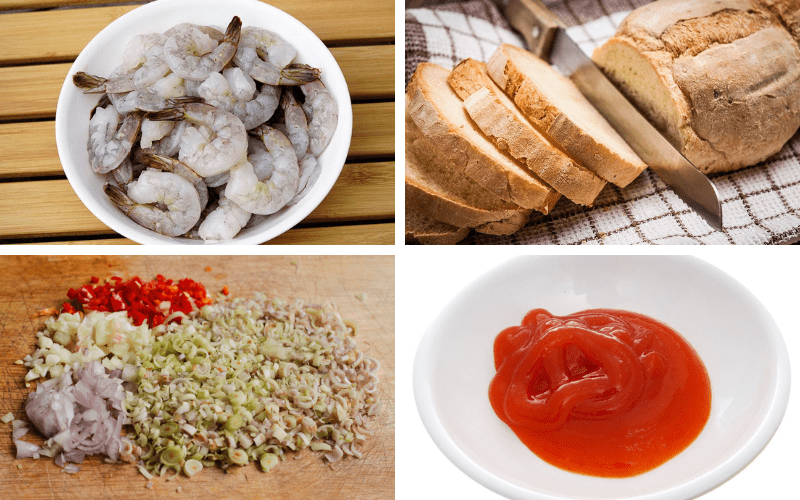
How To Make Vietnamese Shrimp Toast?
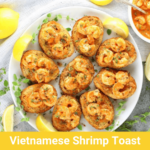
Delve into the world of Vietnamese shrimp toast with our comprehensive guide. Learn this crispy delicacy's traditional recipes, safety considerations, and tantalizing flavors.
- Mixing bowl
- Knife
- Cutting board
- Food processor or blender
- Baking sheet
- Paper towels
- Deep-frying pan or skillet
- Slotted spoon
- 200g raw shrimp, peeled and deveined
- 2 cloves garlic, minced
- 1 stalk lemongrass, white part only, finely minced
- 1 green onions, finely chopped
- 1 tablespoon fish sauce
- 1 teaspoon sugar
- ½ teaspoon ground black pepper
- 4 slices of white bread
- Vegetable oil, for frying
- Fresh cilantro or mint leaves, for garnish (optional)
- Sweet chili sauce or soy sauce, for serving (optional)
Add the raw shrimp, minced garlic, lemongrass, green onions, fish sauce, sugar, and ground black pepper in a food processor or blender. Pulse or blend until a smooth shrimp paste forms.
Cut off the crusts from the bread slices and lightly toast them to remove excess moisture. Alternatively, you can use slightly stale bread for a better texture.
Spread a generous amount of the shrimp paste onto one side of each bread slice, ensuring an even layer.
Heat vegetable oil in a deep-frying pan or skillet over medium heat. Make sure there is enough oil to deep-fry the shrimp toasts.
Carefully place the shrimp toast, shrimp-side down, into the hot oil. Fry until the bottom side turns golden brown and crispy, approximately 2-3 minutes.
Using a slotted spoon, carefully flip the shrimp toasts and fry the other side until golden brown and crispy, approximately 2-3 minutes.
Once cooked, transfer the shrimp toasts to a paper towel-lined baking sheet to drain excess oil.
Repeat steps 5-7 with the remaining shrimp toasts, ensuring not to overcrowd the pan.
Serve the Vietnamese shrimp toasts hot, garnished with fresh cilantro or mint leaves if desired. You can also serve them with sweet chili sauce or soy sauce for dipping.
For visual reference, please refer to the accompanying images below:
Table about nutrient facts of Vietnamese shrimp toast
Nutrient Facts of Vietnamese Shrimp Toast:
| Nutrient | Amount per Serving (1 piece) |
| Calories | 120 |
| Total Fat | 7g |
| Saturated Fat | 1g |
| Cholesterol | 65mg |
| Sodium | 250mg |
| Carbohydrate | 9g |
| Protein | 6g |
| Fiber | 1g |
| Vitamin D | 6% DV |
| Calcium | 4% DV |
| Iron | 6% DV |
| Potassium | 2% DV |
Nutritional value of shrimp
- Shrimp is low in calories and saturated fat, making it a healthy protein choice.
- It is an excellent source of lean protein, providing essential amino acids for muscle growth and repair.
- Shrimp is rich in omega-3 fatty acids, which promote heart health and support brain function.
- It contains vitamins and minerals such as vitamin D, calcium, iron, and potassium, which contribute to overall well-being.
Shrimp’s role in a balanced diet
Shrimp can be part of a balanced diet as it is a low-calorie, high-protein option.
- Incorporating shrimp into meals provides essential nutrients without excess fat or carbohydrates.
- It can be a valuable addition to a diverse and nutritious diet, offering a range of vitamins, minerals, and omega-3 fatty acids.
Note: Nutrient values may vary depending on the specific recipe and cooking method used for Vietnamese shrimp toast.
Is Vietnamese shrimp safe to eat?
Vietnamese shrimp can be safe to eat when certain quality standards and regulations are followed. The government of Vietnam has implemented measures to ensure the safety and quality of shrimp production for both domestic consumption and export.
Quality standards and regulations for shrimp in Vietnam
- The Ministry of Agriculture and Rural Development (MARD) in Vietnam has established guidelines and regulations for shrimp farming and processing.
- These regulations cover areas such as water quality, feed, disease control, and the use of antibiotics and chemicals.
- The National Agro-Forestry-Fisheries Quality Assurance Department (NAFIQAD) monitors and enforces these standards to ensure compliance.
Ensuring safe consumption of Vietnamese shrimp
- When purchasing Vietnamese shrimp, look for trusted sources that adhere to international quality standards and certifications, such as Good Aquaculture Practices (GAP) or the Aquaculture Stewardship Council (ASC) certification.
- Proper cooking is crucial to ensure the safety of shrimp. Shrimp should be cooked thoroughly until opaque and firm, with an internal temperature of 145°F (63°C).
- Practice good hygiene in handling and preparing shrimp. Wash hands, utensils, and surfaces thoroughly before and after handling raw shrimp.
- It is recommended to store and handle shrimp properly, following refrigeration guidelines to prevent bacterial growth.
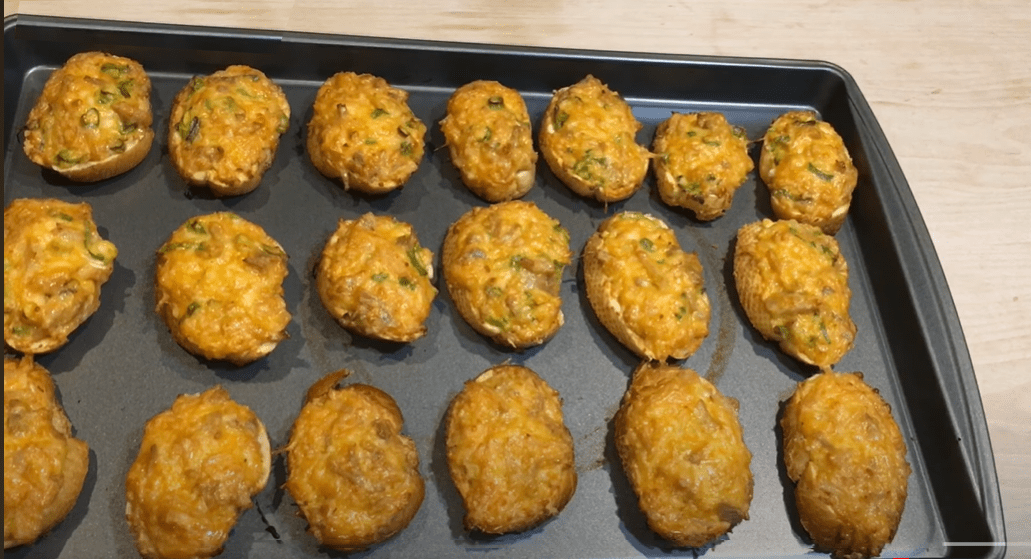
What to serve with Vietnamese shrimp toast?
Vietnamese shrimp toast can be enjoyed on its own or paired with various accompaniments to enhance the dining experience. Here are some delicious options:
- Sweet Chili Sauce: A popular choice, the sweet and slightly spicy flavors of this sauce complement the savory shrimp toast perfectly.
- Soy Sauce: A classic dipping sauce, soy sauce adds a savory and umami element to the shrimp toast.
- Vietnamese Dipping Sauce (Nuoc Cham): This tangy and savory sauce made with fish sauce, lime juice, sugar, garlic, and chili is a traditional and flavorful accompaniment.
- Mayonnaise: Vietnamese shrimp toast with mayo can also be served with a creamy mayo-based dipping sauce. You can enhance the mayo by adding a squeeze of lime juice, chopped cilantro, and a dash of hot sauce for added flavor.
- Fresh Herbs: Serve the shrimp toast with a side of fresh herbs such as cilantro, mint, or Thai basil. The bright flavors of the herbs add a refreshing element to each bite.
- Pickled Vegetables: Tangy and crunchy pickled carrots, daikon radish, or cucumber slices make a delightful contrast to the richness of the shrimp toast.
- Light Salad: Serve the shrimp toast alongside a simple salad of mixed greens or lettuce, dressed with a light vinaigrette. This provides a fresh and vibrant component to balance the flavors.
- Vietnamese Slaw: Create a refreshing Vietnamese slaw using shredded cabbage, carrots, herbs, and a zesty dressing. The crunchy slaw adds texture and complements the shrimp toast nicely.
- Fresh Lime Wedges: Squeeze some fresh lime juice over the shrimp toast to add a citrusy tang and enhance the flavors.
- Jasmine Rice: For a heartier option, serve the shrimp toast with steamed jasmine rice. The fluffy rice acts as a neutral base and helps balance the flavors.
Variations of Vietnamese shrimp toast
Vietnamese shrimp toast offers a versatile base that can be customized with various ingredients and flavors. Here are a few delicious variations to explore:
- Spicy Shrimp Toast: Add a kick of heat to your shrimp toast by incorporating finely chopped chili peppers or a dash of hot sauce into the shrimp mixture. The spicy element adds an extra layer of flavor and excitement.
- Sesame Shrimp Toast: Before frying, sprinkle sesame seeds on top of the shrimp mixture. The sesame seeds will toast during cooking, adding a delightful nutty flavor and a pleasing crunch to the shrimp toast.
- Herbed Shrimp Toast: Enhance the aroma and taste by incorporating fresh herbs like cilantro, mint, or Thai basil into the shrimp mixture. These herbs provide a burst of freshness and complement the shrimp beautifully.
- Cheesy Shrimp Toast: For a decadent twist, sprinkle grated cheese over the shrimp mixture before frying. As the toast cooks, the cheese melts and creates a deliciously gooey and flavorful filling.
- Vegetable-Stuffed Shrimp Toast: Boost the nutritional value by adding finely diced vegetables like carrots, bell peppers, or water chestnuts to the shrimp mixture. These additions add texture and a vibrant touch of color.
- Dipping Sauces: Experiment with different dipping sauces to accompany your shrimp toast. Besides the traditional nước chấm and mayo, you can try sweet chili sauce, hoisin sauce, or peanut sauce for a unique flavor profile.
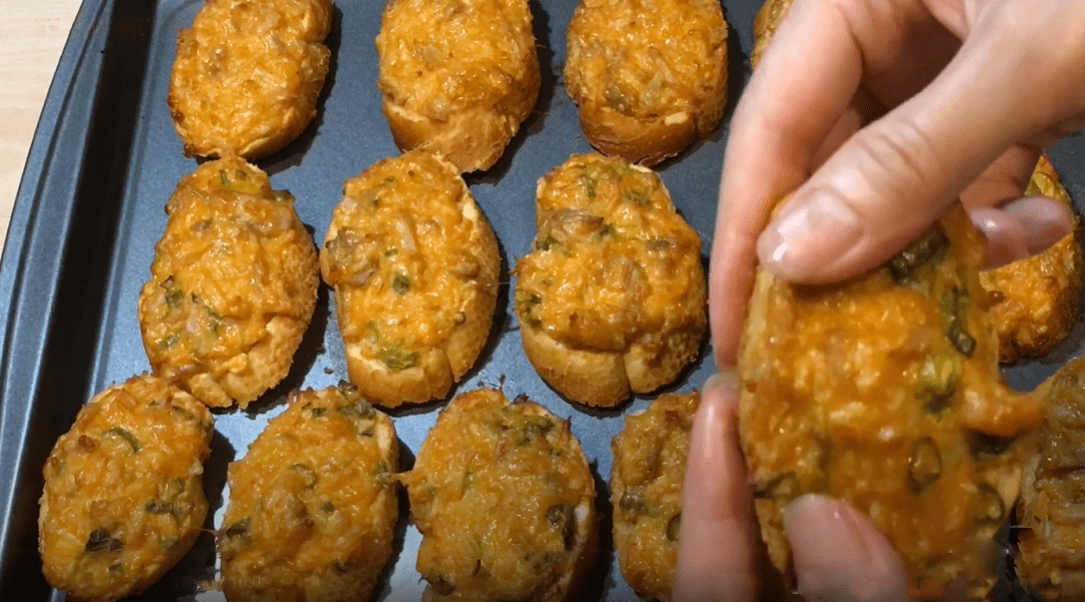
What type of bread is typically used for shrimp toast?
While different variations of bread can be used for shrimp toast, the traditional choice is white bread. Here are some common types of bread typically used for shrimp toast:
- White Bread: White bread is the most commonly used bread for shrimp toast. It has a soft texture and a neutral flavor that allows the shrimp mixture to shine.
- Sandwich Bread: Regular sandwich bread, sliced and crusts removed, is often used for shrimp toast. It provides a good balance between thickness and softness.
- Baguette: In some variations, a baguette may be used for shrimp toast. The crusty exterior of the baguette adds an extra crunch to the texture.
- Brioche: Brioche bread, with its rich and buttery flavor, can be used for a more indulgent and flavorful version of shrimp toast.
- Asian Toast Bread: Asian-style milk bread or toast bread, known for its soft and fluffy texture, is another popular choice for shrimp toast. It offers a tender bite and absorbs the flavors of the shrimp mixture well.
These bread options can be sliced into the desired shape and size, with or without the crusts, to create the base for shrimp toast.
Substitute ingredients for Vietnamese shrimp toast
If you want to explore alternative options or have dietary restrictions, here are some substitute ingredients you can use for Vietnamese shrimp toast:
- Vegetarian/Vegan Option: Replace the shrimp with finely chopped or mashed tofu for a vegetarian or vegan version of shrimp toast. Season the tofu mixture with soy sauce, garlic, and other desired seasonings for a flavorful alternative.
- Fish or Seafood Alternatives: Instead of shrimp, you can use other seafood options like crabmeat, minced fish, or scallops. These alternatives will provide a similar seafood taste and texture to the toast.
- Chicken or Pork: If you prefer a different meat option, finely minced or ground chicken or pork can be used as a substitute for shrimp. Make sure to season the meat mixture with suitable spices and herbs to enhance the flavors.
- Mushrooms: For a vegetarian or vegan option, mushrooms such as shiitake or oyster mushrooms can be finely chopped or processed to create a flavorful mushroom paste. The texture and umami flavor of mushrooms can mimic the taste of shrimp.
- Mixed Vegetables: Create a vegetable-centric version by using a combination of finely chopped vegetables like carrots, bell peppers, water chestnuts, and peas. Ensure the vegetables are finely minced or processed to resemble the texture of shrimp.
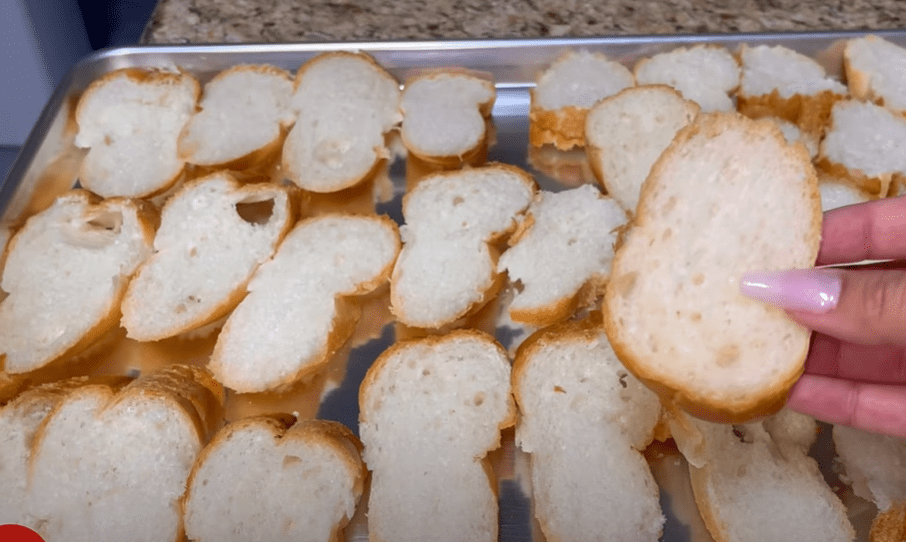
How to store Vietnamese shrimp toast?
If you have leftover Vietnamese shrimp toast or want to prepare them in advance, proper storage is essential to maintain their texture and flavor. Here are the recommended steps for storing shrimp toast:
Cooling
Allow the cooked shrimp toast to cool completely at room temperature before storing. This helps prevent condensation and sogginess during storage.
Refrigeration
Place the cooled shrimp toast in an airtight container or sealable plastic bag. Refrigerate them promptly to preserve their freshness.
Separation
If you need to stack the shrimp toast, place a layer of parchment paper or wax paper between each piece to prevent them from sticking together.
Refrigerator shelf life
Shrimp toast can be stored in the refrigerator for up to 2 to 3 days. However, note that the longer they are stored, the softer the texture may become.
Reheating
To reheat refrigerated shrimp toast, preheat the oven to 350°F (175°C). Place them on a baking sheet and bake for about 5 to 10 minutes, or until heated through and crispy again.
Note: It is generally not recommended to freeze shrimp toast, as the texture may suffer upon thawing and reheating.
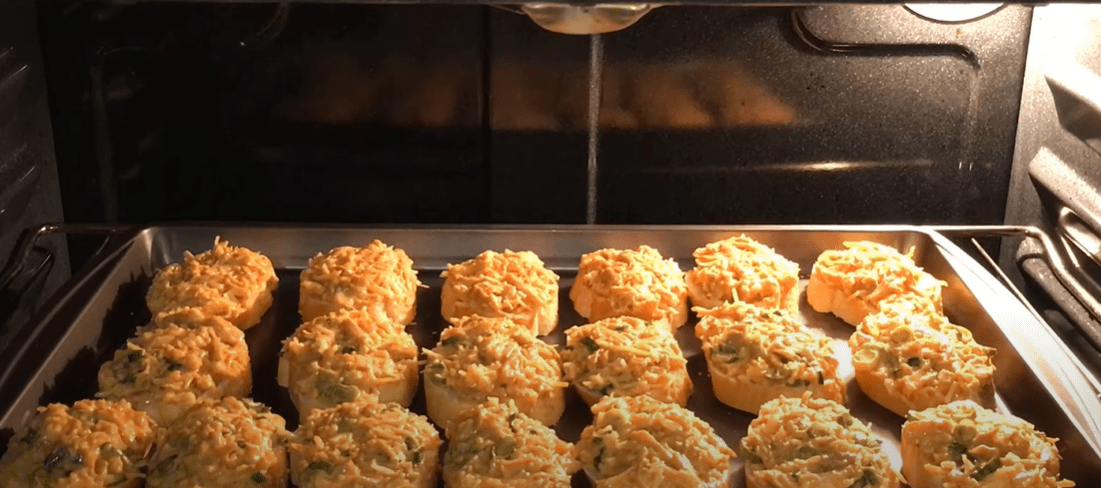
Common mistakes when making Vietnamese shrimp toast
While making Vietnamese shrimp toast, it’s important to be aware of common mistakes that can affect the overall taste and texture. Here are some pitfalls to avoid:
- Overloading the Toast: One common mistake is spreading too much shrimp mixture on the bread, which can lead to uneven cooking and a heavy, soggy texture. Apply a thin, even layer of shrimp paste to ensure proper frying and crispiness.
- Insufficient Toast: If the bread slices are not toasted adequately before spreading the shrimp mixture, they may become too soft and absorb excess oil during frying. Lightly toast the bread beforehand to help maintain its structure and prevent it from becoming overly greasy.
- Inadequate Oil Temperature: Frying shrimp toast in oil that is not hot enough can result in greasy and soggy outcomes. Ensure the oil is properly heated to achieve a crispy and golden-brown texture. Use a cooking thermometer or perform a temperature test by dropping a small piece of bread into the oil – it should sizzle and turn golden brown quickly.
- Crowding the Pan: Overcrowding the frying pan or skillet can cause the shrimp toast to cook unevenly and result in a longer cooking time. Fry the shrimp toasts in batches, leaving enough space between them to ensure they cook evenly and become crispy.
- Insufficient Drainage: Failing to properly drain the fried shrimp toast on paper towels after cooking can lead to excess oil retention, making them greasy. Allow the shrimp toast to drain on paper towels or a wire rack to remove excess oil and maintain their crispiness.
- Inadequate Seasoning: Shrimp toast relies on flavorful seasoning to enhance its taste. Make sure to season the shrimp mixture adequately with ingredients like garlic, ginger, fish sauce, and spices to bring out the desired flavors.
Tips and tricks for perfect shrimp toast
Achieving the perfect shrimp toast requires attention to detail and a few expert tips. Here are some valuable tips and tricks to help you achieve the best results:
- Use Fresh Shrimp: Opt for fresh, high-quality shrimp for the best flavor and texture in your shrimp toast. Fresh shrimp will result in a more succulent and tasty filling.
- Process the Shrimp Properly: Ensure that the shrimp is properly peeled, deveined, and finely minced or processed. A smooth and evenly textured shrimp paste will result in a more cohesive filling.
- Season the Shrimp Mixture: Season the shrimp mixture generously with garlic, ginger, fish sauce, and any desired spices or herbs. Taste the mixture before spreading it on the toast to ensure it is well-seasoned.
- Toast the Bread Lightly: Lightly toast the bread slices before spreading the shrimp mixture to remove excess moisture. This helps maintain a crispier texture.
- Use the Right Cooking Oil: Choose a high smoke point oil like vegetable oil or peanut oil for frying. These oils can withstand higher temperatures, resulting in better frying and a crispier texture.
- Maintain the Right Oil Temperature: Heat the oil to the proper temperature (around 350°F or 180°C) before adding the shrimp toast. This helps achieve an optimal crispy exterior while ensuring the shrimp inside cooks thoroughly.
- Fry in Small Batches: Avoid overcrowding the frying pan or skillet. Fry the shrimp toast in small batches, allowing enough space for them to cook evenly and maintain their crispiness.
- Drain Excess Oil: Once the shrimp toast is fried, place them on a paper towel-lined baking sheet to drain excess oil. This helps remove any residual oil and keeps the toast crispy.
- Serve Immediately: Shrimp toast is best enjoyed immediately after frying to retain its crispiness. Serve it hot and fresh for the most enjoyable experience.
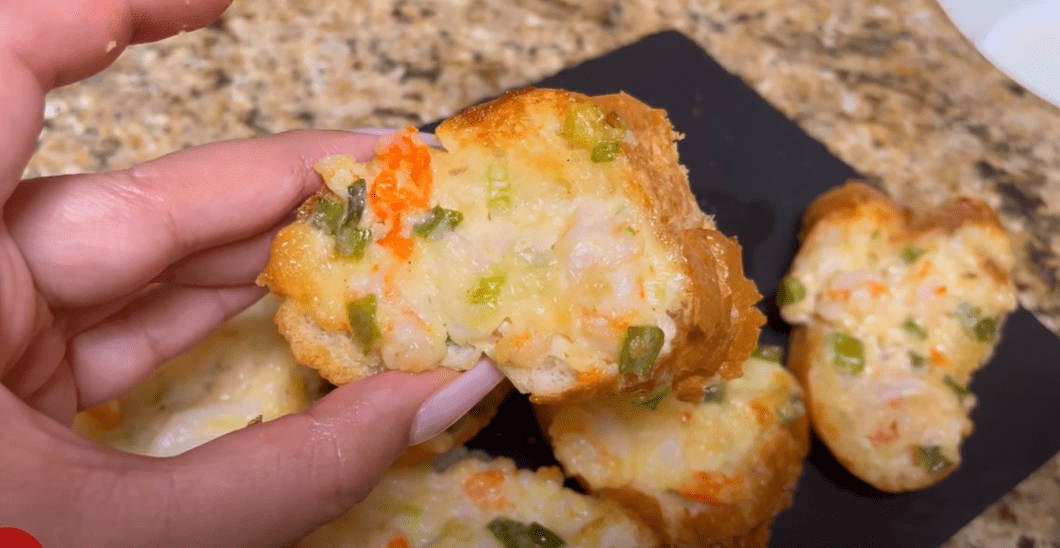
FAQs
Can I use frozen shrimp for shrimp toast?
Yes, you can use frozen shrimp for making shrimp toast. When using frozen shrimp, ensure they are properly thawed before preparing the shrimp mixture. Thaw the shrimp in the refrigerator overnight, or follow the package instructions for quick thawing methods.
Once thawed, pat the shrimp dry with paper towels before using them in the shrimp paste for shrimp toast. Using properly thawed shrimp will help maintain the texture and flavor of the shrimp toast.
Is shrimp toast suitable for vegetarians?
Traditional shrimp toast is not suitable for vegetarians as it contains shrimp, which is a seafood product. However, you can make vegetarian or vegan versions of shrimp toast by substituting shrimp with plant-based ingredients like tofu, mushrooms, or other suitable alternatives.
These alternatives can provide a similar texture and taste while catering to vegetarian or vegan dietary preferences. Make sure to use vegetarian-friendly seasoning and sauces as well.
How do you pronounce “shrimp toast” in Vietnamese?
In Vietnamese, “shrimp toast” is pronounced as “bánh mì tôm chiên.” The pronunciation is roughly as follows: “bun mee tom chyen.”
Can I make shrimp toast without deep-frying?
While traditional Vietnamese shrimp toast is deep-fried to achieve its signature crispy texture, it is possible to explore alternative cooking methods. Baking or air frying can be used as healthier alternatives to deep-frying.
However, it’s important to note that these methods may result in a slightly different texture compared to the classic deep-fried shrimp toast. Adjustments in cooking time and temperature may be required to achieve the desired crispiness.
How do I properly thaw frozen shrimp for shrimp toast?
To properly thaw frozen shrimp for shrimp toast, follow these steps:
- Place the frozen shrimp in a bowl or colander.
- Rinse the shrimp under cold running water to remove any ice crystals.
- Fill a larger bowl with cold water and submerge the shrimp in it.
- Let the shrimp sit in the water for about 15-20 minutes, or until fully thawed.
- Gently agitate the shrimp occasionally to ensure even thawing.
- Once thawed, pat the shrimp dry with paper towels before using them in the shrimp toast.
How do I achieve a crispy texture for shrimp toast?
To achieve a crispy texture for shrimp toast, consider the following tips:
- Toast the bread slices before spreading the shrimp mixture. Lightly toast them to remove excess moisture and help maintain their crispiness during frying.
- Ensure that the oil is heated to the proper temperature (around 350°F or 180°C) before adding the shrimp toast. The hot oil quickly seals the exterior, creating a crispy crust.
- Avoid overcrowding the frying pan or skillet. Fry the shrimp toast in small batches, allowing enough space for them to cook evenly and maintain their crispiness.
- Use a high smoke point oil, such as vegetable oil or peanut oil, for frying. These oils can withstand higher temperatures without burning, resulting in better crispiness.
- After frying, transfer the cooked shrimp toast to a paper towel-lined baking sheet to drain excess oil and help preserve their crispiness.
- Serve the shrimp toast immediately while they are still hot and crispy for the best texture.
What oil is best for frying shrimp toast?
For frying shrimp toast, it is recommended to use an oil with a high smoke point to achieve the best results. Some suitable oils for frying shrimp toast include:
- Vegetable oil
- Peanut oil
- Canola oil
- Sunflower oil
- Grapeseed oil
These oils have higher smoke points, which means they can withstand the heat required for frying without breaking down or smoking excessively. Using oils with high smoke points helps ensure that the shrimp toast achieves a crispy and golden-brown texture during frying.
Is shrimp toast gluten-free?
Shrimp toast, as traditionally made, is not gluten-free. The bread used for shrimp toast typically contains gluten. However, it is possible to make gluten-free shrimp toast by using gluten-free bread or alternative gluten-free ingredients for the toast base.
Additionally, when preparing the shrimp mixture, it is important to check the ingredients used for any potential sources of gluten, such as soy sauce or certain seasonings. By using gluten-free alternatives for these ingredients, you can create a gluten-free version of shrimp toast that suits dietary restrictions or preferences.
Always double-check the ingredients used in both the bread and the shrimp mixture to ensure that they are gluten-free if you require a gluten-free option.
Can I use shrimp with the shell on for shrimp toast?
It is generally recommended to peel and devein the shrimp before using them for shrimp toast. The shell can be tough and detract from the desired texture of the shrimp toast. However, if you prefer to use shrimp with the shell on, you can certainly do so.
Keep in mind that the shell may affect the texture and presentation of the shrimp toast. If using shrimp with the shell on, ensure that they are properly cleaned and deveined before incorporating them into the shrimp mixture.
Are there any health concerns with consuming shrimp toast?
When prepared and cooked properly, shrimp toast is generally safe to consume. However, there are a few health considerations to keep in mind:
- Allergies: Shrimp is a common allergen, and individuals with shellfish allergies should avoid shrimp toast to prevent an allergic reaction.
- Cross-Contamination: Ensure proper handling and hygiene to prevent cross-contamination with raw shrimp or other ingredients. Clean and sanitize utensils, surfaces, and hands after handling raw shrimp.
- Cooking Temperature: Properly cook shrimp toast until the internal temperature reaches 145°F (63°C) to ensure the shrimp is cooked through and safe to consume.
- Quality and Sourcing: Ensure that the shrimp used for shrimp toast is fresh and sourced from reputable suppliers to minimize the risk of foodborne illnesses.
As with any food preparation, it is important to practice good food safety measures, including proper handling, storage, and cooking techniques, to ensure the safety of shrimp toast and minimize any potential health concerns.
How can I make shrimp toast spicier?
If you prefer to add some heat and make your shrimp toast spicier, here are a few options to consider:
- Chili Peppers: Finely chop or mince fresh chili peppers, such as Thai bird’s eye chili or serrano pepper, and incorporate them into the shrimp mixture. Adjust the amount based on your desired level of spiciness.
- Hot Sauce or Chili Sauce: Add a few dashes of your favorite hot sauce or chili sauce to the shrimp mixture. Sriracha, sambal oelek, or other chili sauces can provide a spicy kick.
- Red Pepper Flakes: Sprinkle a pinch or two of red pepper flakes into the shrimp mixture to add subtle heat. Adjust the amount to suit your taste.
- Spicy Seasonings: Incorporate spices known for their heat, such as cayenne pepper, paprika, or chili powder, into the shrimp mixture. Start with small amounts and adjust to your desired level of spiciness.
- Hot Pepper Oil: Use hot pepper-infused oil to fry the shrimp toast. This will infuse the toast with a spicy flavor during the cooking process.
Conclusion
For the most part, Vietnamese shrimp toast is a culinary delight that combines the flavors of succulent shrimp and crispy toast, showcasing the ingenuity of Vietnamese cuisine. With its rich historical background and cultural significance, shrimp toast holds a special place in Vietnamese culinary traditions.
By following a simple yet flavorful recipe, you can create shrimp toast that tantalizes the taste buds. The crispy exterior gives way to a savory shrimp filling, resulting in a harmonious blend of textures and flavors.
While enjoying shrimp toast, it’s important to prioritize safety by sourcing fresh shrimp from reputable suppliers and adhering to proper cooking techniques. Quality standards and regulations ensure the safety and integrity of shrimp in Vietnam.
Shrimp toast offers versatility and variations to cater to individual preferences. From spicy additions to unique fillings, there are endless opportunities to explore and personalize this beloved dish.
Whether served as an appetizer, party snack, or main course, Vietnamese shrimp toast is a delightful addition to any culinary repertoire. It’s flavorful profile and cultural significance make it a true gem of Vietnamese cuisine.
So, embark on a culinary adventure and savor the crispy, succulent goodness of Vietnamese shrimp toast. Let this culinary delight transport you to the vibrant streets of Vietnam, where food is a celebration of flavors and traditions.